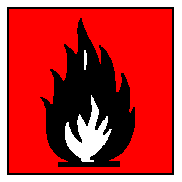International Chemical Safety Cards
| PHOSPHORUS (YELLOW) | ICSC: 0628 |
PHOSPHORUS (YELLOW) |
 |
 |
| TYPES OF HAZARD/ EXPOSURE |
ACUTE HAZARDS/ SYMPTOMS |
PREVENTION | FIRST AID/ FIRE FIGHTING |
| FIRE | Highly flammable. Gives off
irritating or toxic fumes (or gases) in a fire. |
NO open flames, NO sparks, and
NO smoking. NO contact with flammable substances. NO contact with air. NO contact with hot
surfaces. NO contact with oxidants, halogens, sulfur and strong alkalis. |
Water spray, wet sand. |
| EXPLOSION | |
|
In case of fire: keep drums,
etc., cool by spraying with water. |
| EXPOSURE | |
AVOID ALL CONTACT! |
IN ALL CASES CONSULT A DOCTOR! |
| INHALATION | Burning sensation.
Unconsciousness. Symptoms may be delayed (see Notes). |
Ventilation. |
Fresh air, rest. Half-upright
position. Artificial respiration if indicated. Refer for medical attention. |
| SKIN | Skin burns. Pain (further see
Inhalation). |
Protective gloves. Protective
clothing. |
Remove contaminated clothes.
Rinse skin with plenty of water or shower. Refer for medical attention. Wear protective
gloves when administering first aid. Keep contaminated clothes and shoes under water or
sand/earth; do NOT use soap for cleaning. |
| EYES | Pain. Loss of vision. Severe
deep burns. |
Safety goggles. |
First rinse with plenty of water
for several minutes (remove contact lenses if easily possible), then take to a doctor. |
| INGESTION | Abdominal cramps.
Unconsciousness (further see Inhalation). |
Do not eat, drink, or smoke
during work. |
Rinse mouth. Do NOT induce
vomiting. Give nothing to drink. Rest. Refer for medical attention. |
| SPILLAGE DISPOSAL | STORAGE | PACKAGING & LABELLING | ||
| Evacuate danger area! Consult an
expert! cover spilled substance with wet sand or earch. Do NOT wash away into sewer. Sweep
spilled substance into containers then remove to safe place (extra personal protection:
complete protective clothing including self-contained breathing apparatus). |
Fireproof. Separated from strong
oxidants, food and feedstuffs. Cool. Keep under water. |
Airtight. Unbreakable packaging;
put breakable packaging into closed unbreakable container. Do not transport with food and
feedstuffs. F symbol T+ symbol R: 17-26/28-35 S: 5-26-28-45 UN Hazard Class: 4.2 UN Subsidiary Risks: 6.1 UN Packing Group: I |
||
| SEE IMPORTANT INFORMATION ON BACK | ||||
|
||||